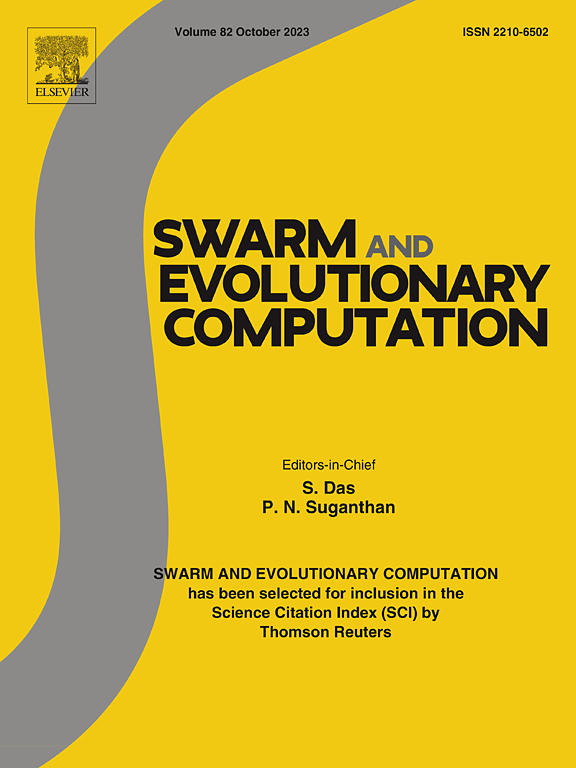基于虚拟信息素和振动声通信的分散式异步机器人群协调框架
IF 8.5
1区 计算机科学
Q1 COMPUTER SCIENCE, ARTIFICIAL INTELLIGENCE
引用次数: 0
摘要
在应用于机器人技术时,生物启发方法所使用的污名物质的动态表示和控制提出了重大挑战。为了克服这一挑战,本工作提出了一个基于虚拟化和局部范围内控制这些物质的框架,其主要目标是协调机器人群。该框架引入了一种新颖的信息素表示,使分散和决策异步成为可能,同时其轻量级设计确保了资源受限平台的可访问性。每个机器人在其内存中保持一个独立的虚拟信息素地图,该地图通过其自身的信息素沉积和蒸发不断更新。此外,每个机器人的信息素地图也会通过汇总其他机器人在附近区域探索的信息来更新。因此,个体和独立的地图消除了中央代理管理和分发信息素信息的需要。这种传播机制的灵感来自蚂蚁的振动声通信,这是一种间接通信的形式。使用基于智能体的大规模仿真工具和真实世界的仿真平台对该框架进行了评估。实验是为了在不同的环境中验证这个框架,这些环境中有不同的形状、大小和机器人的数量。结果表明,该方案能够有效地进行机器人群的协调,机器人在执行监视任务时表现出满意的性能。本文章由计算机程序翻译,如有差异,请以英文原文为准。
PheroCom: Decentralised and asynchronous robot swarm coordination framework based on virtual pheromone and vibroacoustic communication
Representing and controlling the dynamics of stigmergic substances used by bio-inspired approaches pose significant challenges when applied to robotics. In order to overcome this challenge, this work proposes a framework based on the virtualisation and control of these substances at a local scope, with the primary goal of coordinating robot swarms. This framework introduces a novel pheromone representation that enables decentralisation and decision asynchronicity, while its lightweight design ensures accessibility to resource-constrained platforms. Each robot maintains an independent virtual pheromone map in its memory, which is continuously updated through its own pheromone deposits and evaporation. Additionally, each robot’s pheromone map is also updated by aggregating information from other robots that are exploring nearby areas. Consequently, individual and independent maps eliminate the need for a centralised agent to manage and distribute pheromone information. This propagation mechanism is inspired by ants’ vibroacoustic communication, which is characterised as a form of indirect communication. The framework was evaluated using an agent-based mass simulation tool and a real-world simulation platform. Experiments were conducted to validate the framework in diverse environments, with variations in shapes, sizes, and the number of robots. Results demonstrated that this proposal can effectively perform the coordination of robot swarms, and the robots have exhibited satisfactory performance while executing the surveillance task.
求助全文
通过发布文献求助,成功后即可免费获取论文全文。
去求助
来源期刊

Swarm and Evolutionary Computation
COMPUTER SCIENCE, ARTIFICIAL INTELLIGENCEC-COMPUTER SCIENCE, THEORY & METHODS
CiteScore
16.00
自引率
12.00%
发文量
169
期刊介绍:
Swarm and Evolutionary Computation is a pioneering peer-reviewed journal focused on the latest research and advancements in nature-inspired intelligent computation using swarm and evolutionary algorithms. It covers theoretical, experimental, and practical aspects of these paradigms and their hybrids, promoting interdisciplinary research. The journal prioritizes the publication of high-quality, original articles that push the boundaries of evolutionary computation and swarm intelligence. Additionally, it welcomes survey papers on current topics and novel applications. Topics of interest include but are not limited to: Genetic Algorithms, and Genetic Programming, Evolution Strategies, and Evolutionary Programming, Differential Evolution, Artificial Immune Systems, Particle Swarms, Ant Colony, Bacterial Foraging, Artificial Bees, Fireflies Algorithm, Harmony Search, Artificial Life, Digital Organisms, Estimation of Distribution Algorithms, Stochastic Diffusion Search, Quantum Computing, Nano Computing, Membrane Computing, Human-centric Computing, Hybridization of Algorithms, Memetic Computing, Autonomic Computing, Self-organizing systems, Combinatorial, Discrete, Binary, Constrained, Multi-objective, Multi-modal, Dynamic, and Large-scale Optimization.
 求助内容:
求助内容: 应助结果提醒方式:
应助结果提醒方式:


